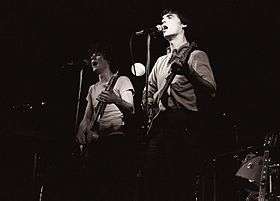Jay's Longhorn Bar

Jay's Longhorn Bar, most frequently referred to by patrons as The Longhorn, was a nexus of the punk music scene in Minneapolis, Minnesota, in the late 1970s and early 1980s,[1] described by music critics as a "legendary"[2] part of the genre's history and a "punk rocker's paradise."[3] One of the earliest clubs in America to regularly book punk, New Wave, and alternative-rock bands,[4] the Longhorn was the only concert stage in Minnesota where touring acts in those genres could regularly perform until the opening of what would become First Avenue in 1980.[5] "The Police, Blondie, all the big acts played there,"[6] wrote Hüsker Dü guitarist Bob Mould, who frequented the venue and noted that he considered Hüsker Dü "an actual band" only after they had performed on the Longhorn stage. Robert Wilkinson, singer for Minneapolis punk band Flamingo, noted that in terms of importance to the scene, “The Longhorn was Minneapolis’ CBGB’s.”[7]
The Longhorn was also an important crucible of the local punk-rock scene. It was the first bar ever played by both of the scene's most highly influential bands, Hüsker Dü (on May 13, 1979)[6] and the Replacements (on July 2, 1980).[8] Peter Jesperson, the Replacements' manager and a founder of Twin/Tone Records, who was also a DJ at the Longhorn at that time,[9] signed the band to Twin/Tone immediately after that performance.[10] Influential Minneapolitan New Wave band the Suburbs also had their first major success at the Longhorn; drummer Hugo Klaers said that after getting regular gigs at the venue, "we went from nobodies to this super popular band. It was just crazy. The Longhorn shows were always packed." One notable audience member at the Suburbs' shows was Bruce Springsteen, then on tour supporting his album The River, who was so impressed with the band that he nearly joined them on stage for an encore.[11]
Located at 14 South Fifth Street in downtown Minneapolis, the Longhorn was opened by owner Jay Berine on June 1, 1977,[4] with help from general manager-artist director-musician/Songwriter Al Wodtke (of Badfinger, KYX, Crow, and Apostles). The Longhorn became a notable punk rock and hardcore punk venue, booking bands such as the Clash, Buzzcocks, Gang of Four,[12] Talking Heads, Dead Boys, Robert Gordon, Mink De Ville,[4] Iggy Pop, the Stranglers,[13] the Flamin' Oh's, the Suburbs, the Suicide Commandos,[14] the Hypstrz, Naked Raygun, the Effigies, the Ramones, Pere Ubu, Lily Tomlin, the Plasmatics,[15] Elvis Costello, Curtiss A, and the Nerves. Before it was an established punk rock venue, the Longhorn hosted a thriving jazz scene. It was home base for the progressive jazz group Natural Life and brought with it many national and international jazz acts.[3]
Chris Osgood, singer-guitarist of the Suicide Commandos, described the Longhorn as "like CBGB in that it was a long bar with a low ceiling and the band was up on a riser at one end of the room. It had been a Nino's Steakhouse before it turned into a bar, so it was not a dump."[5]
The bar was later sold to a new owner, Hartley Frank, who changed it into a pizzeria called Zoogies in the spring of 1982.[7] The location is now a storage center for Xcel Energy.[11]
In popular culture
Nostalgia for the heyday of the venue was the focus of Minnesota musician Dylan Hicks's song "The Longhorn Days", from his 1998 album Poughkeepsie.
On May 16, 2015, a "Longhorn Bar Reunion" was held at First Avenue and 7th St Entry in Minneapolis. Local bands and performers (including X-Boys, Curtiss A, Hypstrz, Flamin'-Oh's, Yipes, and members of the Suburbs and the Suicide Commandoes, billed as "the Sub-Commandoes"), many containing members who played at Jay's Longhorn, paid tribute.[7]
References
- ↑ Walsh 2007, p. 28
- ↑ Walsh 2007, p. 146
- 1 2 Metsa 2011, p. 57
- 1 2 3 Kozek, Roman (1977-11-12). "Punk rock scene shows spate of new club outlets". Billboard: 1, 44. Retrieved 2014-09-15.
- 1 2 Cost, J., Earles, A., Fritch, M., Hickey, M., Klinge, S., Miller, E., Olson, D., Rowland, H., Ryan, M., and Valania, J.: A Tale of Twin Cities: Hüsker Dü, the Replacements and the Rise and Fall of the ’80s Minneapolis Scene, Magnet, June 12, 2005.
- 1 2 Mould 2011, p. 18
- 1 2 3 Bream, Jon (2015-05-14). "It's a rock 'n' roll reunion for the Longhorn Bar, once the Twin Cities' epicenter of cool". Star Tribune. Minneapolis. Retrieved 2016-05-06.
- ↑ Walsh 2007, p. 11
- ↑ Walsh 2007, p. 61
- ↑ Walsh 2007, p. 63
- 1 2 Swensson, Andrea (2015-05-15). "'We started a scene': Minneapolis musicians remember the Longhorn Bar". Retrieved 2016-05-06.
- ↑ Mould 2011, p. 21
- ↑ "PunkFunkRockPop: The Minnesota Music Collection". Minnesota Historical Society. Retrieved 2014-09-15.
- ↑ Mould 2011, p. 13
- ↑ Walsh 2007, p. 99
- Bibliography
- Metsa, Paul (2011). Blue Guitar Highway. University of Minnesota Press. ISBN 978-1452933214.
- Mould, Bob (2011). See a Little Light: The Trail of Rage and Melody. Little, Brown, and Company. ISBN 0-316-04508-X.
- Walsh, Jim (2007). The Replacements: All Over but the Shouting. Voyageur Press. ISBN 0-760-33062-X.
External links
- TCPUNK forum thread on the Longhorn
- Pioneering local musicians reunite to celebrate the Longhorn Bar
Coordinates: 44°58′45.82″N 93°16′17.71″W / 44.9793944°N 93.2715861°W